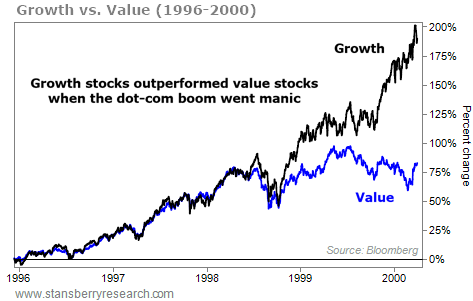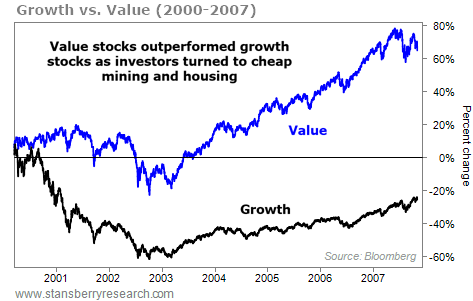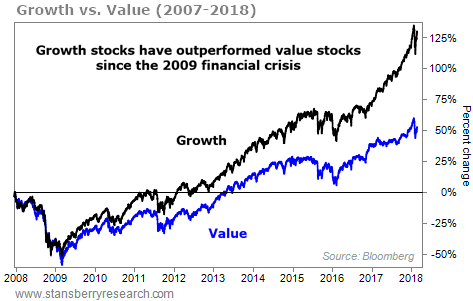| Steve's note: I've said it before... This isn't what a top feels like. I expect big gains in stocks before we see a peak. But the "Melt Up" will end eventually. And my colleague Dan Ferris believes that when it happens, one classic investing model will see a return to glory. Today, he explains why, and why it could mean new opportunities for investors...
| This Profitable Investing Strategy Is About to Make a Comeback | | By Dan Ferris, editor, Extreme Value | | Wednesday, February 28, 2018 |
| I've warned about the ongoing stock market mania since May last year.
And if you've ever wondered what comes after the mania and its inevitable crash, this is the answer...
I believe we're about to see an extended period in which buying good businesses trading at historically cheap valuations – "value stocks" – results in much higher returns than buying fast-growing businesses trading at high valuations – "growth stocks."
Today, I'll explain more about this idea – and why the Golden Age of Value Investing has finally dawned...
----------Recommended Links---------
 | Urgent 'Melt Up' Survey
Steve is inviting all Stansberry readers to take a video survey about the "Melt Up." Just watch a short video and answer one question. It will reveal how well you're positioned to take advantage of Steve's latest bold prediction. Take the survey now. |
|---|
 | Rule 501 Is a Major Threat to Your Retirement
What the government won't tell you about a nasty federal regulation sweeping the country... and how it could affect millions of U.S. seniors in 2018. If you're over age 50, it could have a major impact on your wealth. Learn more. |
|---|
---------------------------------
The market cycles consistently between growth and value. Growth has outperformed since 2009.
But if you look at the stock market's history and developments in certain sectors of the economy today, the signs show that value could soon overpower growth again.
Just look at this comparison of the Russell 3000 Value and Growth Indexes from the dot-com era...

If you look closely at the chart, you'll see growth outperformed value the whole time, even in the early years of the dot-com boom. When the boom went manic around 1998, growth stocks rocketed higher.
This resulted in the single most overvalued moment in U.S. stock market history. (Until recently, perhaps.)
We know what happened next... Technology stocks, telecom stocks, and other Main Street and Wall Street favorites melted down. Many of the survivors – like Internet leader Cisco (CSCO), chipmaker Intel (INTC), telecom behemoth AT&T (T), and troubled industrial giant General Electric (GE) – still haven't seen their share prices return to dot-com era highs. Many companies went to zero.
After the crash, investors ran from tech stocks. They returned to more conservative, value-priced plays in mining, banking, housing, and mortgages. A new crop of value investors was born. The cycle shifted. And value trounced growth...

So what happened? What set up the outperformance in growth stocks that we've been seeing over the past several years?
It was the financial crisis of 2008...
Wall Street turned conservative housing, mortgage, and banking plays into toxic waste through excessive leverage and complex financial schemes like collateralized debt obligations ("CDOs") – "layer cakes" of risky debt securities that blew up in the financial crisis – and credit default swaps ("CDSs"), which were insurance policies on those piles of toxic debt.
Leading up to the collapse, all the mining, housing, mortgages, and other previously cheap and safe opportunities got absurdly expensive. The mania accelerated as individuals locked in cheap mortgage rates for overpriced housing and engaged in "flipping" (buying and selling houses for a quick profit).
We know what happened next... The housing bubble imploded. The biggest economic crisis since the Great Depression nearly destroyed the global financial system. And investors fled the poisonous assets.
Feeling burned by the value plays gone sour in the crisis, investors turned back to technology, including social media, e-commerce, solar power, and electric cars. Growth has outperformed value since 2009...

We're nearing the end of the growth cycle. And it looks like value is about to take charge once again.
Over the long term, value trumps growth. As I wrote to my Stansberry Research colleagues in October...
A study by Nobel Prize winner Eugene Fama and Ken French, two of the greatest investment researchers of all time, compared value investing with growth investing in 13 markets around the world and concluded:
"Value stocks have higher returns than growth stocks in markets around the world. For 1975-95, the difference between the average returns on global portfolios of high and low book-to-market stocks is 7.6% per year, and value stocks outperform growth stocks in 12 of 13 major markets."
In market after market all over the world, value investing can't be beat. |
|
Investors forget about the power of value strategies and need to rediscover them every 10 years or so. This time is no different.
Growth has been in charge since 2009 – the second-longest bull market on record. Based on history, we can expect at least eight years of value outperformance when this growth cycle is done.
This next period could be the Golden Age of Value Investing. And for investors focused on buying great businesses at cheap prices, it could be one of the most profitable times you ever see in the markets.
Good investing,
Dan Ferris
Editor's note: Dan just made what could be the biggest prediction of his career. It's his brand-new No. 1 recommendation... a stock that could return as much as 1,995% over the long term. This idea is already getting a lot of attention – which means time is running out. Click here to learn more. |
Further Reading:
"Multibaggers take time," Dan says. "If you can't be patient, you can't get rich in stocks." To learn more about how a long-term, value-focused approach can give you a competitive edge in the markets, check out his essay: Think Like a Business Owner, Not Like a Trader. "Stocks are super-expensive right now," Dan writes. In this four-part series, he offers his view of this bull market – and reveals how to prepare for the next crash, whenever it strikes. Read the first essay right here: The Key to Surviving a Speculative Mania. |
|

IT'S A BULL MARKET IN EXPENSIVE STEAKS
Today, we highlight a unique economic "gauge"... Regular readers know we check in on certain economic "bellwethers" from time to time. Many industries can tell us a lot about how money is flowing in America. We often look for strength in areas like railway companies, ski resorts, and swimming pools to gain insight. Today, this idea is pointing us toward a high-end steakhouse chain... Ruth's Hospitality Group (RUTH) operates more than 150 Ruth's Chris Steak House restaurants. The company is known for serving high-quality steaks, finished with butter, on a sizzling 500-degree plate. This level of service isn't cheap... So when Ruth's is making money, it's a good gauge of consumer confidence. Last quarter, the company reported a big 15% jump in its sales from last year. And its profits surged 41%. As you can see in the chart below, shares have ripped higher recently. They're up nearly 50% over the past year... and recently hit a fresh new all-time high. It's more proof that American consumers are confident today... |
| 
A boring medical company with a secret asset... It's hard to find bargains in the markets when everything's headed up. But value investing isn't only about what's cheap by the numbers... |
Are You a
New Subscriber?
If you have recently subscribed to a Stansberry Research publication and are unsure about why you are receiving the DailyWealth (or any of our other free e-letters), click here for a full explanation... |
|
Advertisement
They know how much money you have... your wife's name... your pet's name... and the name of the street you grew up on. The crypto technology that will stop them could be 38 times bigger than bitcoin. And you don't need a special account to buy it. Details here. |

| Interest Rates Are About to Go... DOWN? | | By Dr. Steve Sjuggerud | | Tuesday, February 27, 2018 |
| | It doesn't matter what the investment is – whenever you see EVERYONE betting the same direction on a trade, that trade is typically almost over... |
| | Your Financial Adviser Is Lying to You | | By Dr. Steve Sjuggerud | | Monday, February 26, 2018 |
| | I HATE IT when I get letters like the one below... because I hate it when people try to mislead our subscribers... |
| | The 'Debt Jubilee' Is Getting Mainstream Attention | | By Justin Brill | | Saturday, February 24, 2018 |
| | Americans continue to borrow like mad. But this trend is unsustainable... |
| | Three Steps to Survive the Next 'Black Monday' Crash | | By Chris Mayer | | Friday, February 23, 2018 |
| | When the next crash comes, they'll blame the machines. And they'll be wrong – again... |
| | Two Reasons Oil Prices Are Headed Lower | | By Brett Eversole | | Thursday, February 22, 2018 |
| | The plan was to cut production by 1.2 million barrels of oil per day through 2018. And the cartel is keeping its promise so far... |
|
|
|
|

